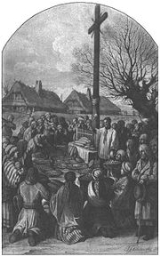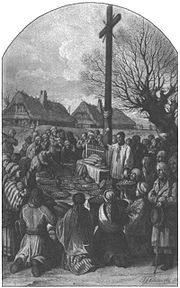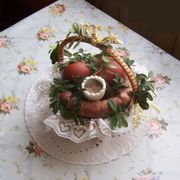
Swieconka
Encyclopedia

Poland
Poland , officially the Republic of Poland , is a country in Central Europe bordered by Germany to the west; the Czech Republic and Slovakia to the south; Ukraine, Belarus and Lithuania to the east; and the Baltic Sea and Kaliningrad Oblast, a Russian exclave, to the north...
traditions on Holy Saturday
Holy Saturday
Holy Saturday , sometimes known as Easter Eve or Black Saturday, is the day after Good Friday. It is the day before Easter and the last day of Holy Week in which Christians prepare for Easter...
. While originally observed by Polish American
Polish American
A Polish American , is a citizen of the United States of Polish descent. There are an estimated 10 million Polish Americans, representing about 3.2% of the population of the United States...
s in the U.S., it has become increasingly mainstream in U.S and is starting to grow in the U.K. as the Polish go there to live. Catholic churches, being observed by a wide cross-section of parishes.
For example, the Chicago Tribune reported Francis Cardinal George of the Archdiocese of Chicago performing the blessing in a church on Chicago
Chicago
Chicago is the largest city in the US state of Illinois. With nearly 2.7 million residents, it is the most populous city in the Midwestern United States and the third most populous in the US, after New York City and Los Angeles...
's Northwest Side on Holy Saturday of 2007. In 2008, a similar service took place in the Chicago archdiocese at St. Alphonsus Liguori Roman Catholic Church in Mt. Prospect, Illinois.

Linen
Linen is a textile made from the fibers of the flax plant, Linum usitatissimum. Linen is labor-intensive to manufacture, but when it is made into garments, it is valued for its exceptional coolness and freshness in hot weather....
or lace
Lace
Lace is an openwork fabric, patterned with open holes in the work, made by machine or by hand. The holes can be formed via removal of threads or cloth from a previously woven fabric, but more often open spaces are created as part of the lace fabric. Lace-making is an ancient craft. True lace was...
napkin and decorated with sprigs of boxwood
Buxus
Buxus is a genus of about 70 species in the family Buxaceae. Common names include box or boxwood ....
(bukszpan), the typical Easter evergreen. Poles take special pride in preparing a decorative and tasteful basket with crisp linens, occasionally embroidered for the occasion, and boxwood and ribbon woven through the handle. Observing the creativity of other parishioners is one of the special joys of the event.
While in some older or rural communities, the priest visits the home to bless the foods, the vast majority of Poles and Polish American
Polish American
A Polish American , is a citizen of the United States of Polish descent. There are an estimated 10 million Polish Americans, representing about 3.2% of the population of the United States...
s visit the church on Holy Saturday, praying at the Tomb of the Lord (the fourteenth and final Station of the Cross
Stations of the Cross
Stations of the Cross refers to the depiction of the final hours of Jesus, and the devotion commemorating the Passion. The tradition as chapel devotion began with St...
). The Blessing of the Food is, however, a festive occasion. The three-part blessing prayers specifically address the various contents of the baskets, with special prayers for the meats, eggs, cakes and breads. The priest or deacon then sprinkles the individual baskets with holy water
Holy water
Holy water is water that, in Catholicism, Anglicanism, Eastern Orthodoxy, Lutheranism, Oriental Orthodoxy, and some other churches, has been sanctified by a priest for the purpose of baptism, the blessing of persons, places, and objects; or as a means of repelling evil.The use for baptism and...
.
More traditional Polish churches uses a straw brush for aspersing
Aspergillum
An aspergillum is a liturgical implement used to sprinkle holy water. It comes in two common forms: a brush that is dipped in the water and shaken, and a perforated ball at the end of a short handle...
the water; others use the more modern metal holy water sprinkling wand. In some parishes, the baskets are lined up on long tables; in others, parishioners process to the front of the altar carrying their baskets, as if in a Communion line. Older generations of Polish Americans, descended from early 19th century immigrants, tend to bless whole meal quantities, often brought to church halls or cafeterias in large hampers and picnic baskets.
The foods in the baskets have a symbolic meaning:
- eggs - symbolize life and Christ's resurrectionResurrectionResurrection refers to the literal coming back to life of the biologically dead. It is used both with respect to particular individuals or the belief in a General Resurrection of the dead at the end of the world. The General Resurrection is featured prominently in Jewish, Christian, and Muslim...
- bread - symbolic of JesusJesusJesus of Nazareth , commonly referred to as Jesus Christ or simply as Jesus or Christ, is the central figure of Christianity...
- lamb - represents Christ
- salt - represents purification
- horseradish - symbolic of the bitter sacrifice of Christ
- ham - symbolic of great joy and abundance.
The food blessed in the church remains untouched until Sunday morning.
See also
- Easter eggEaster eggEaster eggs are special eggs that are often given to celebrate Easter or springtime.The oldest tradition is to use dyed or painted chicken eggs, but a modern custom is to substitute chocolate eggs, or plastic eggs filled with confectionery such as jelly beans...
- Egg decorating in Slavic cultureEgg decorating in Slavic cultureThe tradition of egg decoration in Slavic cultures originated in pagan times, and was transformed by the process of religious syncretism into the Christian Easter egg...
- Pisanka (Polish)

